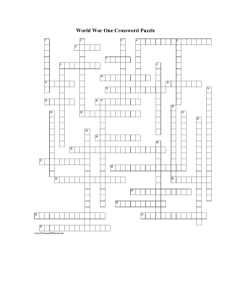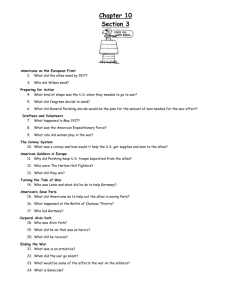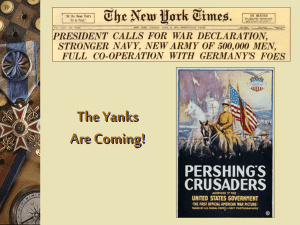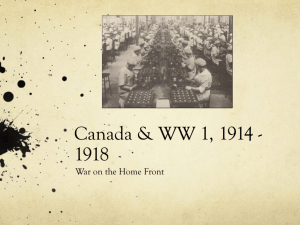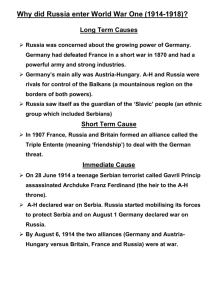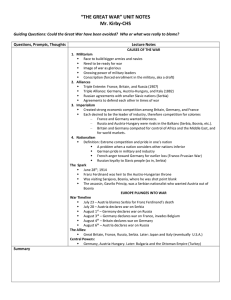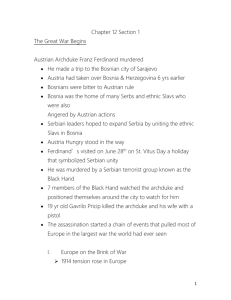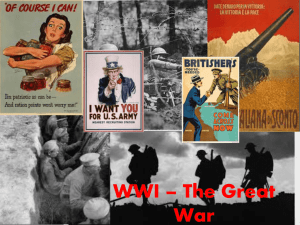The World War I Era
advertisement
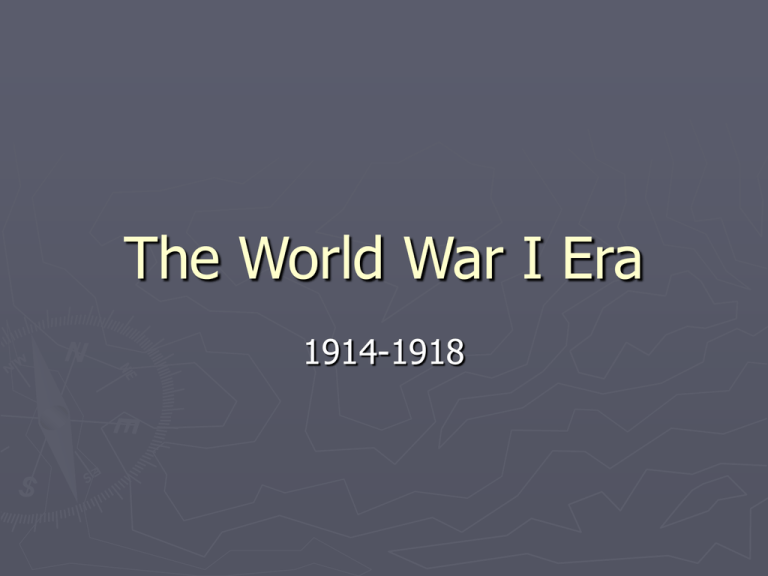
The World War I Era 1914-1918 Central Question: When is a nation justified in waging war? The Road to War The Causes ► Imperialism—competition for land, colonies and possessions intensified and Japan joined the race as an imperialistic nation. ► Militarism—aggressively building military strength in preparation for war—practiced by Austria-Hungary, France, Germany, Great Britain, and Russia ► Nationalism—countries acted in their own interest and ethnic minorities pushed for independence. ► Alliances—countries entered into entangling alliances both openly and secretly The Catalyst ► Assassination Arch Duke Francis Ferdinand and wife Sophie were visiting Sarajevo, Bosnia Serbian Nationalist, Gavrilo Princip shot them both to death on June 28, 1914 Austria blamed Serbia for the deaths. The War Escalates ► July 28, 1914—Austria-Hungary declared war on Serbia ► July 29—Russia (Serbia’s protector) mobilized for war. ► Germany’s (A-H’s chief ally) warned Russia and began mobilizing. ► France (Russia’s ally) began to mobilize ► August 1, 1914—Germany declared war on Russia ► Germany initiated the Schlieffen Plan (knock out France quickly, then attack Russia) ► The German army took Belgium on the way to France. ► August 4—British (Belgium’s protector) declared war. The Sides ► Central Powers—Germany, Austria-Hungary, and later the Ottoman Empire. ► Allies—Russia, France, Great Britain, Serbia, and later the US, Italy, and Japan. Stalemate ► Most thought the war would end in 6 weeks. ► Neither side gained advantage and the conflict became a war of attrition. ► Both sides soon settled into trench warfare. Modern Warfare ► The War Introduced: Machine guns Long range artillery shells Hand grenades Poison gas Tanks Barbed Wire Air planes / Dirigibles America’s Response ► To protect investments, Pres. Wilson declared the US neutral on August 4, 1914. ► Americans were primarily isolationists. ► Most Americans, however, disliked the Germans b/c of the Kaiser. ► Despite isolationism, there was a strong “Preparedness” movement to prepare the US if it were drawn into the war. The US Declares War German Submarine Warfare ► Germany used U-Boats to attack ships w/o warning. ► May 7, 1915—The Lusitania (UK ship) was sunk and 128 Americans died. ► May 20, 1916—Germany sand a French passenger ship the Sussex ► Under pressure Germany issued the Sussex Pledge—warn ships b/4 attacking Prelude to War ► February 1, 1917—Germany resumed unrestricted submarine warfare. ► Feb 3—US broke diplomatic relations w/ Germany ► Zimmermann Note00Arthur Zimmermann (GR Foreign Sec.) sent a note w/ a secret offer to Mexico—regain lost lands in US in exchange for joining the Central Powers when war broke with the US. ► Russian Revolution By 1917 had lost 1.8 million, 24 million were POWs, and 2.8 million were sick or wounded. March 1917—Czar Nicholas II was overthrown by Communists under Vladimir Lennin March 3, 1918 Russia Left the War ► March 16-18, 1917—Three US ships were sank by the Germans ► War Declared April 6, 1917—Congress declared war. Americans on the Front Preparation ► Americans were very unprepared for the war. (120K enlisted 80K national guard) ► Forces were placed under Spanish-American War veteran Gen. John J. Pershing. ► Pershing took 14,500 men to Europe. ► He then asked for 1 million by 1918 and 3 million by 1919. ► May 1917—Congressed Passed the Selective Service Act 24 million registered 3 million were drafted Few objected b/c this was thought to be the “War to end all wars.” Draftees, volunteers and Guardsmen became the American Expeditionary Force (AEF) ► Navy implemented the Convoy System— Merchant and troops ships traveled surrounded by destroyers and torpedo boats. Turning the Tide ► Overview When Russia left the war, GR turned all its strength toward the UK and FR lines. It is the arrival of the Americans that turns the tide of the war. ► Americans Save Paris Battle of Chateau-Thierry ►June 1918, GR forces were 50 miles from Paris ►Brigadier Gen. James G. Harbord declared, “We dig no trenches to fall back on. The marines will hold where the stand.” ►Paris was saved. ►US lost over ½ their men in the battle ► The Allied Counter-Attack Began to use tanks to break GR lines August 8—Battle of Amiens—Allies stopped the GR advance completely. Battle of St. Mihiel—Gen. Pershing defeated the Germans and sent them into full retreat. Allies began to use planes to drop bombs Corporal Alvin York ► Born in Tennessee ► Fought in the final Allied assault—MeuseArgonne Offensive ► Single handedly killed 25 machine gunners in a machine gun nest and captured 132 Germans. ► Later told the General, “. . . I would hate to think I missed any of them shots; they were all pretty close range—50 or 60 yards.” Armistice ► Signed Movember 11, 1918, at 11:00 AM ► Over 50K Americans died in battle; more of sickness and disease. ► 8 million Europeans died / 5K a day The Home Front Paying for the War ► The government sold Liberty Bonds to the public. ► Raised over $20 million. The War Economy ► War Industries Board—oversaw war related production. ► War Trade Board—regulated trade. ► War Labor Board / Labor Policies Board— settled disputes, set wages, set hours, and regulated working conditions. ► Congress gave the President the power to regulate food and fuel Price controls and rationing were instituted. Reduced consumption was encouraged— “Meatless Mondays” and “Wheatless Wednesdays.” Daylight savings time was implemented to reduce fuel consumption. Enforcing Loyalty ► Americans feared that foreigners might try to undermine the war effort. ► There was great hostility toward Germans and any immigrant. ► German Measles became “Liberty Measles; Hamburger the “Liberty Burger” ► Congress passed the Espionage Act and later the Sedition Act. Prohibition ► 1917—Congress proposed 18th Amendment partly because of the need for grain. ► Ratified in 1919. Peace!!! Wilson’s Plan—The Fourteen Points ► Had 14 Provisions which included An end to entangling alliances Removal of trade barriers Reduction of armaments National self-determination for ethnic groups / colonies. No spoils or reparations— “Peace without Victory” Formation of the League of Nations Paris Peace Conference ► The Other Allies wanted to divide up Germany’s colonies. ► France pushed for the humiliation and destruction of Germany. ► Wilson was forced to compromise. Treaty of Versailles ► Germany was forced to: Give up its colonies Sign the War Guilt Clause Pay the Allies $33 billion Demilitarize the Rhineland Dismantle its army Give France control of the coal assets in the Saar Valley ► Established the League of Nations ► US Congress never ratified the treaty b/c of the League of Nations provision. Congress later negotiated separate peace w/ each of the Central Powers.

